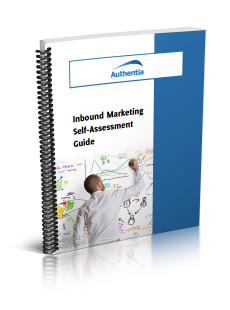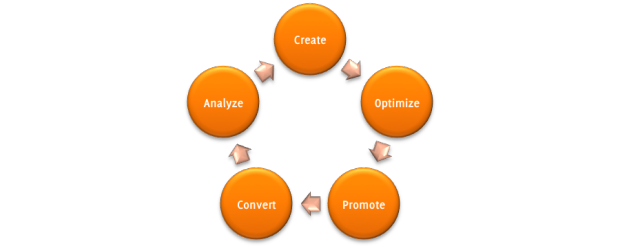 You’ve read the blog posts, viewed the webinars, attended the conferences, bought the t-shirts. Maybe you even hired a consultant or two to help move the ball forward. You’ve either dipped a toe in the water or done a head-first swan dive into the inbound marketing pool. I guess there’s one question to ask at this point.
You’ve read the blog posts, viewed the webinars, attended the conferences, bought the t-shirts. Maybe you even hired a consultant or two to help move the ball forward. You’ve either dipped a toe in the water or done a head-first swan dive into the inbound marketing pool. I guess there’s one question to ask at this point.
How’s that workin’ out for ya?
Inbound marketing has a lot of moving parts. They all need to be working together with consistent execution. It’s easy to leave some steps out, so taking stock once in a while and performing a self-assessment can be worthwhile.
Note: A downloadable PDF of this article is available. It includes some additional details about how to score yourself against the 26 criteria. Click here to download your free inbound marketing self-assessment.
Inbound Marketing Self-Assessment Overview
In order for this self-assessment to provide value, you need to have at least a basic working knowledge of inbound marketing. This self-assessment covers the five major components of inbound marketing:
- Create remarkable content that your customers will find interesting and want to share with their peers. This content must be engaging and provide value to the consumer. It is not another vehicle for delivering your brochures. The more pages your website has, the more attention it will receive from the search engines.
- Optimize the content for search engines so that it is easily indexed and ranks for relevant keywords.
- Promote your content over a wide range of channels including social media.
- Convert leads into customers through landing pages with strong calls to action.
- Analyze the performance of each and every step in order to continuously adjust and improve.
Each of the following sections provides a breakdown of the 26 individual scoring criteria for the five principal activities of inbound marketing. Read through each section and assign yourself a score from 0 to 4.
Content
 Inbound marketing starts with creating compelling content that your target audience will want to share with others…
Inbound marketing starts with creating compelling content that your target audience will want to share with others…
Blog Structure
The most effective means for delivering remarkable content is via a blog. There are several reasons why this is the case. First, each blog post appears as a new page on your web site. The more pages search engines find, the more they love your site. Second, most blog engines these days are at least moderately optimized for search “out of the box,” which means they do much of the heavy lifting for you; URL rewriting, page titles and headings, meta tags, etc… Third, they incorporate features that make easy for visitors to subscribe, share, and engage with your site.
Readability
Everybody believes they are victims of information overload these days. Author and thought leader Clay Shirky believes it is more accurate to categorize the situation as “filter failure,” but either way the solution to this is simplicity. In most cases, visitors to your web site are going to decide whether or not to stay in just a few seconds. The language you’re using had better be concise, simple, and direct. Readability is a relative measure of the complexity and length of your sentences. The longer and more complicated they are, the less your chances that a visitor will stick around.
To measure the readability of your content, use the Flesch Reading Ease formula:
Quantity
A wealth of information on your website demonstrates several things. For one, it’s a sign that your company is active and dynamic (as opposed to dormant or stagnant). Also, it is a tacit gesture of good faith to your audience that implies commitment and generosity. In a word, it shows you care.
Applicability
Does your content talk about stuff you care about, or stuff your audience cares about? Ideally you can do both at the same time. However, as marketing guru David Meerman Scott says at every chance he gets, “Nobody cares about your products or services. All they care about are their problem(s).” Focus on delivering content that alleviates pain.
Consistency
Let’s assume you have a healthy amount of remarkable content that’s easy to read and highly applicable to your target audience. Hopefully it was posted at regular intervals over a long period of time. I can’t tell you how many web site blogs I visit (many of them marketing companies!) who blasted out of the starting gates six months ago with a dozen blog articles in six days… and then never post again. This is perhaps worse than having no content at all, as it insinuates that you jumped into something without a plan or proper forethought. They may wonder, “Is this the way you run other aspects of your business too?”
Aesthetics
This one is very tough. For one thing, it’s obviously quite subjective. But more importantly, it’s often overrated. Many companies spend tens of thousands of dollars to have designers build incredibly beautiful websites that are invisible to search engines. That’s like building a Starbucks in the middle of the Australian Outback. What’s the point? However, neither is it true that aesthetics don’t matter. Again, simplicity is the order of the day here.
Search Engine Optimization
 The single most important factor (approximately 40%) in how well your site ranks in search engines is the number of inbound links (i.e. links on other sites pointing to a page on yours). The best way to accomplish that is to create remarkable content that people want to talk about. There are also link-building strategies you can employ by actively reaching out and promoting your site, but great content spreads itself. But having said that, it’s also important that you are mindful of the next 30%, which is referred to as “on-page” optimization.
The single most important factor (approximately 40%) in how well your site ranks in search engines is the number of inbound links (i.e. links on other sites pointing to a page on yours). The best way to accomplish that is to create remarkable content that people want to talk about. There are also link-building strategies you can employ by actively reaching out and promoting your site, but great content spreads itself. But having said that, it’s also important that you are mindful of the next 30%, which is referred to as “on-page” optimization.
Inbound Links
When another web site contains a link to yours, it is a signal to the search engines that somebody else values your content enough to tell other people about it. The more “authoritative” their site is, the more “juice” that link provides.
In order to find out how many inbound links exist for your site, use the free Open Site Explorer.
URL Structure
The most important factor in on-page optimization is the page’s URL. In general, they should be short and contain keywords. For example, let’s consider the ubiquitous “About Us” page. These are examples of poor (but very common) URLs:
- www.mycompany.com/?p=1234
This format is very common, as it is the default structure for WordPress sites. However, it is utterly meaningless to search engines. - www.mycompany.com/portal/tabid/62/about.aspx
The problem with this URL is that there is too much “junk” in it. Remember that every word and every character in a URL is a precious asset that should be maximized as much as possible.
So, what’s a good URL for an “About Us” page? Something like “www.mycompany.com/about-mycompany” is ideal.
Page Titles
The second most important on-page optimization is the title of your page. Many websites’ page titles begin with the company name on every single page. This is incredibly wasteful! Your website does not need to be optimized for your company name. Rather, it should be concentrating on the keywords that prospective customers will be using to search for your products and services. For example, the page title for your home page should be something like, “Corporate Event Planner” and not simply “MyCompany.”
Page Headings
This is where we get a little technical. Web pages are written in a language called HTML (Hypertext Markup Language). Every element on a web page is contained inside of markers called “tags.” For example, paragraphs are denoted by the tag “p” and so they are coded as such: <p>You paragraph text goes here…</p>. Headings are important for search engines because the words they contain carry more weight in their eyes. These tags are called “H” tags and come in multiple levels; H1, H2, H3, etc… Your web site should have one (and only one) H1 tag on every page and it should contain important keywords. Sub-headings should use H2, H3, H4, etc… tags and also contain keywords.
Images
Search engines read text. Period. Maybe someday they will be able to look at an image and understand that it’s a picture of a bear on a unicycle, but that day isn’t here just yet. Instead, they rely on what’s called “alt” text and all of the images on your website should have meaningful alt text – ideally with keywords in them. You can tell whether or not an image has alt text associated with it by hovering your mouse over it. Most browsers will display a callout containing the image’s alt text.
Anchor Text
Another thing search engines look for is what’s known as the “anchor text” of a link. Again, they figure that if you’re creating a link to something then it’s slightly more important than the rest of the words in a given paragraph. However, how many times to you see a link that says, “Too see a list of our services, click here”? In this example, the anchor text is “here” and is completely meaningless. A more search engine friendly version of this would be, “Check out our list of corporate event planning services.”
Meta Tags
Ah, the good ole meta tag. In the early days of the web, meta tags were embedded HTML code that told web crawlers what the page was about. This was before the days of Google and keyword-stuffing, “black hat” SEO. Many people still mistakenly believe that meta tags are used by search engines but the truth is unambiguous; they do not. At all. Period. However, that doesn’t mean that they are not important. The “description” meta tag is still used by search engines when your site is returned as the result of a search. It uses that description to populate the text underneath your link. However, it only displays about 160 characters so it’s important to customize every page’s meta description. Think of it as an advertisement for that page.
Promotion
 Creating remarkable content and optimizing it for search is a great start, but it’s relatively passive. To start proactively inbound marketing, you need to promote your content.
Creating remarkable content and optimizing it for search is a great start, but it’s relatively passive. To start proactively inbound marketing, you need to promote your content.
Content Portability
Let’s assume that you’re creating remarkable, relevant content that I want to consume. How easy is it for me to do that? If your content is embedded inside of a Flash Video it’s pretty much impossible. If it’s behind a members’ only walled section of your site, it’s inconvenient. However, if I can download a PDF to my laptop or podcast to my iPod then I can take your content with me and consume at my leisure.
Content Shareability
Yes, I know that “shareability” is not a word – I made it up. It’s a measure of how easy or difficult it is for me to share your content with other people who I think would be interested in seeing it. Your web page should have tools on it that make it simple for me to Tweet, share on Facebook, bookmark, email, etc…
Content Accessibility
How easy is it for me to gain access to your valuable and interesting content? How do I know when there’s new stuff to check out? At a minimum, your site should support RSS (Really Simple Syndication) feeds. Also, opt-in newsletters are great for delivering higher value content.
Social Media
It may seem a little strange that social media gets such a small amount of discussion, but that’s deliberate. Although there’s no denying that social media is a complete game-changer, I wanted to deemphasize it a little bit. Too many businesses (large and small) are jumping in without a plan. If your social media strategy isn’t simply one line item in an overall plan then you run the risk of driving people to a website with poor calls to action and not being able to measure anything. It’s a waste of everyone’s time.
With that caveat, it’s imperative that every business harness the power of social media. Developing a comprehensive strategy is far beyond the scope of this report, but suffice it to say that – at the very least – you must start learning about it and listening.
Activity
Assuming that you have a blog and created social media accounts, how active is your audience with you and vice versa? Today’s Web 2.0 tools make it easier than ever to engage with your audience and humanize your business.
Conversion
 Conversion is the process of transforming visitors into leads and leads into customers. To do so, you need to have systems and strategies in place to move people through that process. And it all begins by asking them to do something.
Conversion is the process of transforming visitors into leads and leads into customers. To do so, you need to have systems and strategies in place to move people through that process. And it all begins by asking them to do something.
Calls to Action
Hint: your “Contact Us” page does not constitute a call to action. Almost every page on your website should have a clear direction for users to take another step. It may be to learn more, download a white paper, subscribe to a newsletter, etc… Whatever the action, there needs to be something in it for your visitor, it must be clear, it must be simple, and it must be easy.
Landing Pages
Creating customized pages that are destinations from outside sources reduces the friction between the visitor and your call to action. This means that links you publicize through social media channels or advertisements should not land at your homepage, but in a place that recognizes the origin of the user and the reason they probably clicked on the link. Creating custom landing pages makes it easier to craft meaningful calls to action.
Here’s a quick note about the importance of strategy. A solid online marketing strategy is goal-based. These goals should be set out from the beginning and contribute your organization’s goal in material ways. These frequently fall within one of the following three categories; they increase revenue, decrease costs or improve customer service. Once you’ve set forth these goals, prioritize them and establish outcomes on your website that support those goals. These outcomes are always action-based and begin with a verb (e.g. download, register, buy, request, etc…). Each of these outcomes should then have one or more landing pages that are tied in with your web analytics package so that you can track conversion rates for each one of them.
Conversion Forms
Hint: your “Contact Us” page does not constitute a conversion form. When you give a visitor a clear, simple, easy call to action, it generally will lead them to a conversion form. This form also needs to be clear, simple, and easy, but it also must be as frictionless as possible. Don’t ask for more information than is absolutely necessary in order to fulfill the delivery of the value the visitor wants. It should also be specific to the call to action and provide additional information about what will happen after the form is submitted.
Generosity
This is a subjective measurement of the degree to which your content represents a “gift” to the recipient. Inbound marketing is all about delivering value with no immediate expectation of quid pro quo. That is the definition of an act of generosity and seems to be counterintuitive in many business environments. However, the net effect of social media is that marketing and branding power is being transferred out of the hands of the corporations and into the hands of the consumer. This means that businesses that were accustomed to operating under strictly economic norms will need to learn how to operate in a new, hybrid environment of economic and social norms. And one of the best ways to build trust in a new social relationship is to give gifts.
Analytics
 One axiom of business management is, “If it can’t be measured, it can’t be managed.” It’s important to have solid analytics and review them regularly in order to understand how effective your inbound marketing is (or is not) and whether you’re trending up or down.
One axiom of business management is, “If it can’t be measured, it can’t be managed.” It’s important to have solid analytics and review them regularly in order to understand how effective your inbound marketing is (or is not) and whether you’re trending up or down.
Analytics Tool
For this topic, I will simply turn to the guru of web analytics, Avinash Kaushik. The introduction to his book, “Web Analytics 2.0” reads in part, “For far too long our online efforts have accurately been classified as faith-based initiatives. And why not? That’s exactly how we made decisions for our offline efforts, and when we moved online, we duplicated those practices. But online, in the glorious beautiful world of the Web, we do not have to rely on faith.
We live in the most data-rich environment on the planet – an environment where numbers, data, math, and analysis should be the foundation of our decisions. We can use data to determine how to market effectively, how to truly connect without audiences, how to improve the customer experience on our sites, how to invest our meager resources, and how to improve our return on investment, be it getting donations, increasing revenue, or winning elections!”
Webmaster Tool
While analytics tools provide data about the traffic on your website, webmaster tools provide information about the structure and content of your site. They let you know how the site appears to search engines and alert you to problems like broken links.
Utilization
Like the table saw that has sat dormant in my basement for about five years now, a tool is not being used isn’t a tool; it’s an obstruction. In order to be useful, the data from your analytics and webmaster tools must be reviewed regularly – preferably daily – in order to do their jobs.
Integration
Monitoring click-throughs, referral sources and keywords is good. But fully leveraging the capabilities of analytics tools by segmentation and campaign is better. Ideally, the links you sprinkle around the web through social media, emails and advertisements should be coded in order to provide important campaign metrics to your analytics tool(s).
What’s Your Score?
Find the average score of the individual criteria for each of the five sections. Then, average those five numbers together for a composite score.
What the scores mean:
4: Great job! You have implemented most, if not all, best practices for inbound marketing.
3: While you’re doing some facets of inbound marketing, you could see better results with a little improvement.
2: The bad news is that you’re not implementing any inbound marketing best practices. The good news is that you could see huge improvements quickly!
1: Warning! This score indicates that your current practices are actually harming one or more aspects of your inbound marketing
A downloadable PDF of this article is available. It includes some additional details about how to score yourself against the 26 criteria. Click here to download your free inbound marketing self-assessment.

